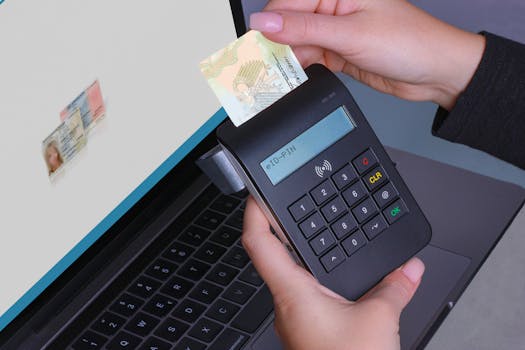Anúncios
New ways to pay, save and invest appear almost every month. The world’s daily habits now change with every wave of fintech innovation, sometimes so smoothly it’s easy to miss the transformation.
Financial apps, payment platforms, and digital wallets aren’t just conveniences; they directly impact access to credit, savings, and economic opportunity at every level. That’s why fintech innovation demands attention far beyond Silicon Valley or Wall Street.
Whether you’re a shopper or small business owner, understanding what fuels fintech innovation will make you better prepared. Read on for actionable insights and practical scenarios that shed light on the trends shaping the global financial future.
Pushing the Boundaries: Digital Ecosystems as Everyday Infrastructure
Access to reliable digital ecosystems puts a world of financial options at your fingertips. As more services integrate, the average person sees fewer barriers, quicker access, and more control over finances.
Consider banking apps that let you pay a friend, pay a bill, and track investments—all within a single dashboard. Fintech innovation turns scattered financial tasks into a unified journey, making money management less daunting.
Integrating Lifestyle and Finance Seamlessly
Picture someone booking travel insurance while reserving a flight, using one app. Digital ecosystems make this scenario possible. The friction melts away; finance becomes a background feature of daily actions.
A parent might use a family sharing wallet, teaching kids about digital allowance management. This real-world teaching tool exists because fintech innovation enables seamless integration across banking and educational apps. The financial lesson becomes part of daily conversation.
Retailers and consumers now use the same platform to exchange, refund, and reward. No one has to dig through email for receipts since payment and communication merge together. Follow this example by reviewing which everyday purchases could be tracked and rewarded in a unified dashboard.
Pillars That Support Scalable Digital Ecosystems
Interoperability matters most. A digital wallet that doesn’t connect to key merchants won’t see adoption. Ecosystems thrive on partnerships—each new connection doubles a user’s options.
Security keeps innovation sustainable. When users trust data privacy and transparent authentication, the system spreads. A robust ecosystem builds a habit of regular usage, as friction fades and confidence rises with every interaction.
Digital ecosystems also depend on speed. Imagine buying a coffee, verifying ID, and paying—all before your drink finishes brewing. To test your own digital readiness, list the services you use now and spot where connectivity could save you 10 minutes weekly.
| Feature | Old Way | Digital Ecosystem | Practical Next Step |
|---|---|---|---|
| Bill Payments | Mail checks or separate logins | Single-tap across vendors | Link all accounts to one dashboard |
| Budgeting | Spreadsheets or notebooks | Automated, real-time alerts | Turn on notifications for purchases |
| Rewards Tracking | Punch cards or receipts | Integrated loyalty balance | Add loyalty info to wallet app |
| Insurance | Separate from purchases | Embedded at checkout | Check apps for insurance add-ons |
| Peer Transfers | Bank visit or cash exchange | Instant mobile transfers | Set up trusted payee list |
Balancing Convenience and Security in a Fintech-Driven World
Implementing practical security steps empowers you to keep personal data safe as fintech innovation expands. Each new platform or app brings both new opportunity and new responsibility.
Enabling two-factor authentication, using apps with transparent privacy policies, and vetting fintech services before connecting accounts solidifies your safety and strengthens confidence in digital transactions.
Security Steps Every User Can Take
Read privacy disclosures from each new provider. Know which data is accessed and how it’s used. Don’t connect your main bank account unless you’re comfortable with both the provider’s track record and their stated security measures in plain language.
Update passwords regularly, and use a password manager if possible. This seemingly small routine supports fintech innovation because wide adoption of security best practices allows platforms to innovate without compromising safety.
- Enable multi-factor authentication: This blocks many basic attacks and keeps your financial data from being compromised easily. It only takes a few minutes per app.
- Limit app permissions: Verify why a fintech app needs specific permissions. Reject unnecessary data requests to minimize exposure and signal privacy matters to developers.
- Vet new fintech tools: Read independent reviews. Observing other users’ real-world feedback helps you choose trusted apps, supporting a safer fintech innovation landscape.
- Use unique passwords: A password reused across accounts risks a cascade breach. Unique passwords contain hacks and protect you even if one provider is compromised.
- Monitor transaction alerts: Prompt notifications give you the power to catch unauthorized activity quickly, setting a practical habit for digital self-defense.
Security habits feel tedious at first—like locking your front door each night—but with repetition, they become second nature. Set calendar reminders each month to review app access and permissions. You’ll spot potential risks before they become damaging events.
Making Security and Convenience Work Together
See security as a feature to personalize, not a hurdle. Saving time is motivating, but rushing can open doors to unwanted intrusions. Balance speed with careful, deliberate action.
- Check summary screens before confirming payments: This small pause lets you catch mistakes and prevents accidental transfers—no extra apps needed.
- Review linked accounts quarterly: Disconnect unused services to limit data exposure and keep financial connections tidy, just like cleaning out an old wallet.
- Opt into suspicious activity alerts: These give you real-time protection without slowing everyday transactions, supporting fintech innovation at every step.
- Research payment insurance options: Some apps now guarantee fraud protection, turning digital “what ifs” into controlled outcomes you design.
- Educate family on safe habits: Teach relatives to recognize scam messages and suspicious prompts, raising the security standard for everyone connected to your finances.
Pairing convenience and security helps you enjoy the benefits of fintech innovation without unnecessary risk. Each step you add shapes a safer and more flexible digital finance experience—today and as new technologies emerge.
Personalizing Financial Journeys with Artificial Intelligence
AI-driven tools personalize advice, making fintech innovation deeply relevant to each user. Data analysis transforms basic transactions into meaningful patterns, helping people set goals, optimize savings, and navigate financial complexity more confidently.
Machine learning and natural language processing allow chatbots to understand plain, everyday questions such as “How can I save for a car next year?” and provide context-specific, actionable steps.
Real-Time Recommendations Improve Outcomes
A user who overspends on weekends may get a Friday morning push notification: “Spending peaked last Saturday—consider setting a lower limit this week.” Instantly actionable tips turn AI into a practical guide.
Automatically categorizing expenses means less time sorting receipts and more time focusing on bigger financial goals. AI learns from the latest transactions, giving real-time insight instead of static summaries.
Custom dashboards adjust based on spending trends. For instance, if recurring subscriptions increase, a fintech app may suggest consolidating or pausing them, making your financial plan more dynamic and responsive.
AI as a Trusted Everyday Guide
Unlike a human advisor who meets quarterly, AI-powered fintech innovation delivers guidance 24/7, responding to real-time changes. You can ask, “Am I on track for my holiday budget?” even after midnight.
AI tools translate complex financial jargon into plain language. A prompt like “What does this fee mean?” reveals clear definitions, not legalese. This lowers barriers and builds long-term financial confidence.
Consider creating quick scripts for common queries. For example: “Show me my large expenses this month.” By testing a few of these on your favorite fintech apps, you’ll spot hidden opportunities and risks quickly.
Big Data’s Role in Predicting Consumer Needs and Behaviors
Aggregated insights from millions of anonymized user actions enable fintech innovation to spot trends and offer predictive experiences. This shifts advisors and app developers from reactive to proactive modes, anticipating needs before users ask.
A credit monitoring service may notice seasonal shopping spikes for an entire segment of consumers and trigger tailored loan or savings offers just when support is most relevant.
Leveraging Predictive Analytics in Daily Financial Planning
Individuals may not notice gradual shifts in spending or income, but Big Data-driven apps catch them instantly. You might receive advice like “Utility bills rise each January—set aside extra now.”
A fintech innovation platform could group your expenses into smart categories, suggesting spending caps based on similar user profiles. These timely nudges help you stick to financial targets without constant manual tracking.
Families who switch to predictive tools find budgeting conversations less stressful. Instead of debating every purchase, they agree on automated category rules shaped by their own patterns—actionable steps for peaceful money discussions.
Building Smarter Offers Through Data-Driven Personalization
Institutions that harness big data can create tailored products. For example, a teen getting their first paycheck might be offered a starter investment account distinct from what a retiree would see.
Over time, a fintech innovation provider builds profiles that go beyond demographics—analyzing behavior for real-life triggers, such as relocating or starting college, and proactively suggesting financial tools that fit that life stage.
Test this by logging into your banking app and checking if it anticipates upcoming bills or recommends savings goals. As adoption grows, expect proactive offers in even more scenarios, from shopping trips to major milestones.
Bringing Smart Devices and Automation into Everyday Money Habits
Embed smart devices and automation in your routines to make managing money effortless and reliable. Voice assistants, wearables, and recurring payment settings open the door to invisible but impactful financial progress.
Fintech innovation now powers everything from hands-free bill payments in your kitchen to fitness trackers rewarding healthy purchases, bridging daily life with proactive financial habits in ways no spreadsheet can match.
Smart Devices Drive Faster, Safer Decisions
Imagine waking up and asking your smart speaker, “What’s my bank balance?” or tapping a wearable device to instantly freeze a lost card. Each gesture builds a secure and practical financial routine.
Integrate location-based prompts, such as reminders to pay for parking only when you arrive at a lot, not weeks later. These micro-automations prevent fees and late charges, reinforcing financial discipline without extra mental effort.
Fine-tune these actions by reviewing your device settings each weekend. Customize which alerts or shortcuts serve your own life pattern, strengthening positive habits that stick.
Automation Reflects and Reinforces Real-Life Priorities
Create automatic savings transfers each payday, making goal progression predictable rather than hoping for leftovers. Most major fintech innovation platforms now support customizable rules based on your cash flow cycle.
Link recurring subscription payments to a single card. This centralizes spending, revealing unwanted renewals quickly and empowering you to pause services with one tap.
An analogy: turning on home lights with a timer guarantees safety even when you’re away. So too does automation preserve financial wellness, even if you forget. Audit your automation rules quarterly to keep them current.
Transparency and Trust: Building User Confidence in the Fintech Age
Making transparency a default feature gives users clarity and control. When fintech innovation is transparent, trust grows and positive word-of-mouth spreads, accelerating adoption worldwide.
Open fee disclosures, clear permissions, and easy-to-understand terms offer reassurance—turning skeptical newcomers into advocates who share success stories with friends and family.
Transparency Enhances Long-Term User Loyalty
Users stick with fintech providers that break down costs in plain language. A simple table showing interest rates or fees up front beats confusing footnotes and hidden charges every time.
Clear statements build repeat usage. If you can show a friend all fees charged last month, you’ll likely keep using—and recommending—that platform. Request transparency reports or summary emails each month.
Transparency also means prompt, honest communication when issues occur. If an app admits payment delays and provides actionable solutions, confidence rebounds even faster. Try contacting customer support after a glitch to assess their transparency culture directly.
User Control Grows With Transparent Data Practices
Data control means letting users see, edit, or delete financial records on demand. This policy signals respect; it’s the fintech innovation way of “locking the house when you leave.”
Clear opt-in controls protect privacy and foster a give-and-take: share limited data for better service, but reclaim it anytime. Practice requesting data export or removal from your favorite platforms to test these safeguards in action.
Transparency becomes contagious. Once you’ve experienced the comfort of complete control, it’s hard to return to opaque financial models. Check for dashboards that explain permissions and offer customization—all signs of trustworthy development.
Fintech Innovation as a Force for Global Inclusion
Platforms designed with accessibility and cultural diversity break down socioeconomic boundaries, making fintech innovation a truly global phenomenon. Expanded access changes lives in tangible ways, shrinking inequality as digital tools reach more people.
Remote workers, rural communities, and non-traditional borrowers now enjoy services unavailable just a few years ago. The shift isn’t just technological—it’s deeply personal for each newly included user.
Expanding Access with Mobile-First Solutions
Smartphone-based banking eliminates the need for physical branches, letting users open accounts with only a device and ID scan. Mobile-first apps give refugees, rural dwellers, and younger generations a straightforward start in managing money.
Community-based lending circles—now digitized—expand credit to those traditionally overlooked by banks. A user can join a virtual group, contribute and borrow, building creditworthiness based on group trust and participation step-by-step.
Remote onboarding and identity verification have made signing up as simple as snapping a photo. Try enrolling for a digital wallet or savings product, noting where processes are simple and where improvements could amplify access.
Designing for Local Relevance in a Global Market
Fintech innovation thrives where apps adapt to local languages, customs, and payment habits. Adding interfaces that mirror local banking norms improves engagement and support, even when global infrastructure powers the backend.
Scenario: In Kenya, mobile money became the default for urban markets by enabling tiny daily transactions in familiar languages. This kind of hyper-local strategy increases adoption wherever global fintech platforms seek local partners.
Test your bank or fintech app for language and accessibility options. Each inclusive design feature lights the path for broader, more equitable financial progress.
Fintech Futures: Practical Steps Toward a Connected Financial World
Fintech innovation rapidly connects people, services, and opportunities, generating ripple effects in everyday life. As digital platforms evolve, practical steps will determine whether changes breed more trust, convenience, and empowerment worldwide.
Reviewing your digital footprint and making proactive updates prepares you for ongoing transformation. Consider which platforms best serve real needs—and stay flexible as tools evolve and new players enter the industry.
Expect faster, smarter personalization as back-end AI and real-time data become table stakes. The future will reward those who regularly assess their digital habits, seeking tools that match changing goals, responsibilities, and risks.
Fintech innovation will expand as people demand more control, security, and inclusivity. Adopt new routines, stay alert for emerging trends, and join the dialogue to ensure tomorrow’s innovations reflect shared values.
The next wave of fintech innovation invites every user to participate, adapt, and shape progress. By staying curious and proactive, you’ll remain at the forefront—ready to make the most of each new financial development.



